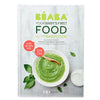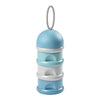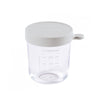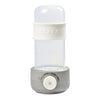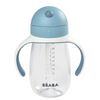The importance of calcium in the first 1,000 days..
Kelly Benton – Pregnancy & Baby Nutritionist
Calcium is a critical nutrient for all of us, responsible for building strong bones and teeth, as well as supporting nerve, heart, and muscle function.
During pregnancy, the body adapts to meet its need for calcium, by increasing intestinal absorption of calcium from food2. During the final 6 weeks, a baby’s skeleton develops rapidly, with 80% of calcium stores being acquired during this time, so ensuring you consume a variety of calcium rich foods across the day is important in meeting the recommended daily intake of 1,000mg3.
When breastfeeding, the primary source of calcium for breastmilk is via maternal bone reabsorption3. The body adapts this way to ensure breastmilk contains a consistent amount of calcium for baby. Whilst evidence shows that bone health is restored, chronically low intakes of calcium could leave a mother at risk of bone density issues later in life, so it is even more important that you meet the daily intake for calcium to replace what is lost from bone1. Continue reading for some of my favourite calcium-rich foods for pregnancy, postpartum and babies!
A 7- to 12-month-old baby needs 270mg calcium per day, of which just under half will be coming from breastmilk (or formula if that’s what you are doing)3 to support the rapid growth that occurs in their first year. For most of us, cow's milk is synonymous with being a good source of calcium, however it is recommended to hold off introducing cow's milk as a drink until your baby reaches 12 months, mainly because of it is associated with an increased incidence of iron deficiency and can displace more nutrient-dense foods4^.
Here are 6 calcium-rich foods that you can safely consume through pregnancy and introduce to your baby once they have started solids:
- Chia seeds: packed with calcium, but also a good source of plant-based protein and omega 3's. When soaked before consumption, chia seeds are also incredible hydrating as they absorb up to 12 x their weight in water. Soak for 15mins in water before adding to your baby's food. Perfect when added to smoothies, purees, gummies, or try a batch of strawberry chia jam which you can all enjoy.
- Sardines*: a powerhouse of nutrients for babies! Opt for wild caught (such as Good Fish) and serve whole for BLW, of mash well with some avocado and lemon juice for a puree version. For mama’s, mash with avo and lemon juice and spread on sourdough alongside some sauerkraut. This is a really simple meal that you can easily eat together.
- White beans: also a source of protein (important for growth) and fibre (supports digestive health). If using dry beans, prepare by soaking in warm water and apple cider vinegar (1 tbsp per cup of beans) for 12-24 hours, then drain, rinse and cook. Add to soups, purees, or fritters (cauliflower and white bean make a great mix).
- Yoghurt*: Contains beneficial bacteria and can be easier to digest for little tummies. Opt for plain Greek yoghurt, organic and full fat. For mama’s, I recommend adding some nutty granola and seeds to make this a protein rich meal.
- Mackerel*: containing a similar nutrient profile to sardines, also containing DHA (important for brain development). Use similar to sardines, such as mashed with avo + lemon, or mix into fritters or pesto pasta.
- Spinach + other dark leafy greens: also a great source of folate, vitamin C, and iron. Add frozen spinach to smoothies, or sauce based meals such as bolognaise, blend with eggs to make scrambled eggs or green pikelets.
^You may have seen that the World Health Organisation (WHO) has recently updated its recommendations around the use of cow’s milk in babies 6-11 months of age, stating that in formula-fed infants, full fat cow’s milk can now be offered as an alternative5. This information is based on a study which compared the effects of cow’s milk to infant formula in babies 6-11 months old. The authors concluded that cow’s milk may increase the risk of anaemia in infants 6-11 months, but that there were no differences in growth between infants in each group. It was acknowledged that both findings were based on low certainty of evidence, meaning very little confidence can be placed in the effects of the study and more research is needed6. It is important to note that the WHO makes global recommendations. Some countries may not have access to formula, or quality drinking water for preparation. This research does not apply to breastfed infants – breastmilk remains the recommended source of milk until 12 months in these babies4,5.
If you are considering introducing cow’s milk to your baby as a drink before 12 months, please discuss with your GP.
*denotes top allergenic food, so introduce to baby one at a time, in small amounts, waiting a few days between introductions.
Kelly Benton is a Nutritionist specialising in maternal and baby nutrition. She is a mother of two little ones, right there in the thick of it with you. After experiencing maternal nutrient depletion through her first pregnancy and postpartum period, Kelly saw a need to educate and empower other women to proactively take health into their hands so they can have a more positive experience. Kelly is available for 1:1 consults, to book please visit her website or Instagram page.
References:
- Institute of Medicine (US) Committee on Nutritional Status During Pregnancy and Lactation (1991). Nutrition During Lactation. Washington (DC): National Academies Press (US). 9, Meeting Maternal Nutrient Needs During Lactation. Available from: https://www.ncbi.nlm.nih.gov/books/NBK235579/
- Kovacs, C.S. (2016). Maternal Mineral and Bone Metabolism During Pregnancy, Lactation, and Post-Weaning Recovery. Physiological Reviews. 96:2, 449-547. DOI: https://doi.org/10.1152/physrev.00027.2015
- National Health and Medical Research Council [NHMRC]. (2017). Nutrient Reference Values for Australia and New Zealand. V1.2. Accessed 28.03.24 via: https://www.nhmrc.gov.au/about-us/publications/nutrient-reference-values-australia-and-new-zealand-including-recommended-dietary-intakes
- (2012). Infant Feeding Guidelines: Information for health workers. Accessed via: https://www.nhmrc.gov.au/file/3341/download?token=RqAoE51K
- World Health Organisation. (2023). Guideline for complementary feeding of infants and young children 6-23 months of age. Accessed via: https://iris.who.int/bitstream/handle/10665/373358/9789240081864-eng.pdf?sequence=1
- Ehrlich, J.M., Catania, J., Zaman, M., Smith, E.T., Smith, A., Tsistinas, O., Bhutta, Z.A., Imdad, A. (2022). The Effect of Consumption of Animal Milk Compared to Infant Formula for Non-Breastfed/Mixed-Fed Infants 6-11 Months of Age: A Systematic Review and Meta-Analysis. Nutrients. DOI: https://doi.org/10.3390/nu14030488






